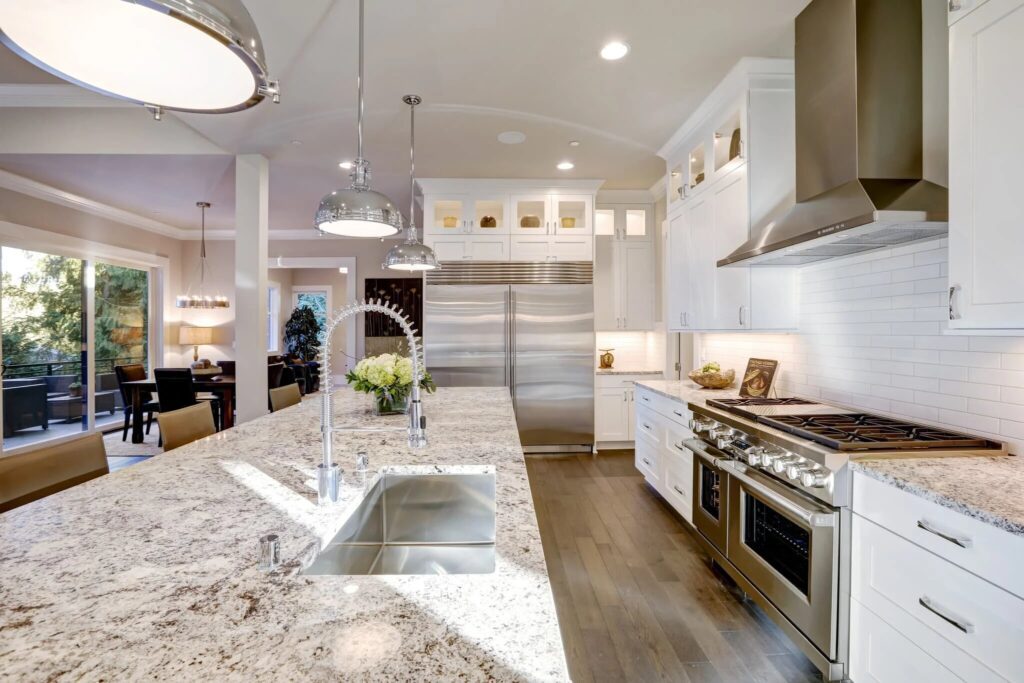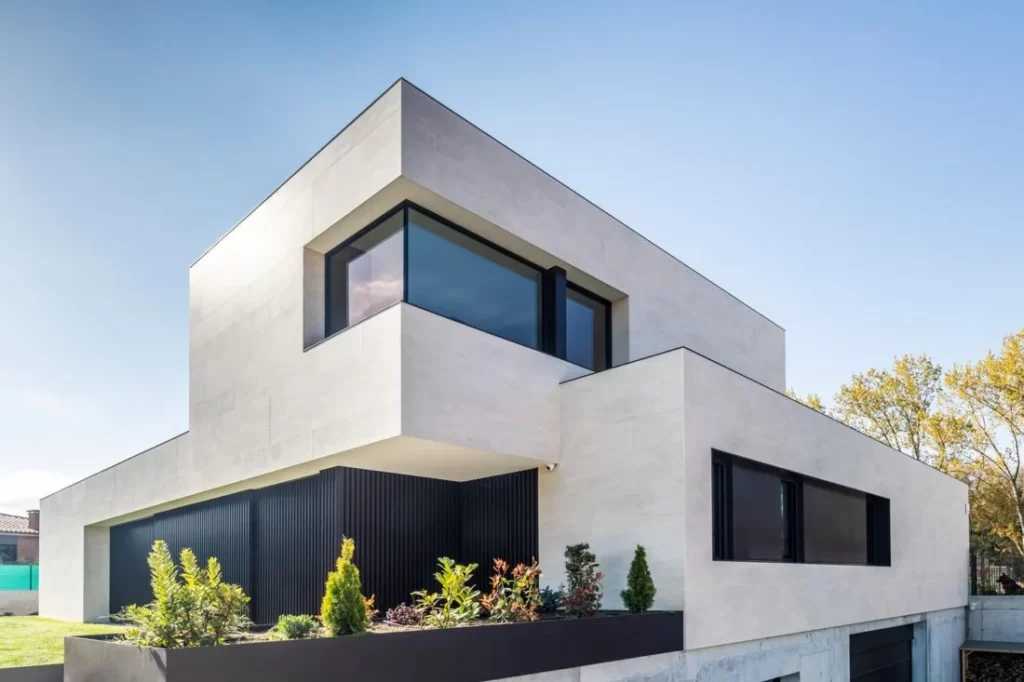Granite is the most sought-after among all building stones. In ancient times, granite was the material of choice for constructing majestic temples and grand palaces, serving as pillars, beams, and protective walls. Today, granite’s use has only expanded thanks to modern technology. Advanced tools, allow for precise cutting and polishing, enhancing granite’s aesthetic appeal and enabled uses of granite in many different ways.

Polished granite slabs are preferred for flooring or surface, while granite tiles are used for cladding. In addition to this, gravestones and monuments of various shapes and sizes are also in vogue. The flexibility of the cutting tools have engendered creation of many artifacts of granite for decorative purposes.
Granite also finds its application in making garden furniture, such as, benches, fountains and many other articles which are used for landscaping and/or decorative purposes.
Raw granites are used for structural purposes after minimal dressing and sizing. The cut-to-size small blocks are used as cobblestone, kerbstone, road sidings and for many other innovative purposes. In contrast, processed granites are primarily employed in building construction, monuments, and both interior and exterior facades.
Due to its high density, hardness, uniform color, low moisture absorption, high heat resistance, and scratch resistance, granite is widely used in various industrial, structural, and heavy-duty applications.
What Is Granite?
Granite is a type of rock that forms deep underground from cooled molten rock, known as magma or also called as lava. It’s made up of several minerals, including quartz, feldspar, and mica, which give it a speckled appearance with various colors and patterns. (Source: Wikipeida)
Its beauty and durability come from how it’s formed: over millions of years, the magma cools slowly, allowing the minerals to crystallize and create a tough, solid rock. This natural process gives granite its unique patterns and colours.
ALSO READ | What Contributes to the Different Granite Colors & Pattern?
Uses of Granite in Interior
Granite is a flexible and commonly utilised natural stone in interior design for a variety of uses. Many homeowners and designers prefer it because of its longevity, aesthetic appeal, and unique patterns. Here are some common uses of granite stone in interiors:
Countertops:
Granite countertops are one of the most popular and widely find uses of granite stone in kitchens and bathrooms. It provide a durable and heat-resistant surface that can withstand daily wear and tear. come in a variety of colors and patterns, allowing homeowners to choose a style that complements their overall design.
Flooring:
Granite flooring adds a touch of luxury to interior spaces. It is highly durable and resistant to scratches and stains, making it suitable for high-traffic areas. Additionally, granite flooring is available in different finishes, such as polished, honed, or flamed, providing various aesthetic options.Backsplashes: Designers frequently use granite as a backsplash in kitchens and bathrooms. It provides both protection against moisture and stains and adds a stylish touch to the space. With its diverse colors and patterns, granite offers endless design possibilities, allowing for creative and functional enhancements in any room.
- Vanities: Granite is a popular choice for bathroom vanities. Its resistance to water and durability make it well-suited for this application. Granite vanities come in various sizes and shapes, providing flexibility in design.
- Granite Wall: In the realm of uses of granite stone, designers often employ granite as wall cladding to create accent walls or add texture and visual interest to a room. Its availability in various thicknesses and finishes allows for versatile design options.
ALSO READ | Does Granite Scratch? Can It Be Scratched? Will Granite Scratch? Learn About Granite Scratch Resistance

- Staircases and Steps: In larger homes, tall buildings, or commercial spaces, architects and builders frequently use granite stone for staircases and steps. The durability of granite ensures that these high-traffic areas maintain their aesthetic appeal over time.

- Tabletops: In the realm of uses of granite stone, designers commonly employ granite tabletops in dining rooms and kitchens. The natural beauty of the stone enhances the overall aesthetic appeal of the space, and its durability makes it a practical choice for a frequently used surface.
Uses of Granite in Heavy Areas
Granite’s durability and strength make it suitable for use in heavy-duty areas where robust materials are essential. Here are some common uses of granite in heavy areas:
Transportation Infrastructure: In the construction of heavy areas of transportation infrastructure, such as airport terminals, railway platforms, and bus terminals, builders make use of granite stone. Its durability renders it suitable for enduring the weight and constant movement of people and vehicles.
- Industrial Flooring: In industrial and manufacturing settings, uses of granite stone encompass flooring due to its resistance to heavy foot traffic, machinery, and potential chemical spills. Its hard surface withstands the wear and tear associated with industrial activities.
Loading Docks: In loading dock areas, construction incorporates granite for places where heavy loads are moved, loaded, and unloaded. The strength of granite ensures its ability to withstand the pressure and impact associated with such activities.
Commercial Kitchens: Granite countertops are popular in commercial kitchens due to their ability to endure heavy use, resist scratches from knives, and withstand exposure to heat. It is a hygienic and durable surface for food preparation.
ALSO READ | Granite and Cooking: Is Granite Safe for Food Preparation and Cooking?
Power Plants: Builders utilize granite stone in loading dock areas where they move, load, and unload heavy loads. Its strength ensures that it can withstand the pressure and impact associated with such activities.
Uses of Grantie in Exteriors and Construction
Due to its durability, strength, and aesthetic appeal, construction widely utilizes granite for various purposes. Here are some common uses of granite in construction:
- Dimension Stone: Contractors commonly use granite as a dimension stone, referring to natural stone that they have selected and fabricated to specific sizes or shapes. They employ it in constructing building facades, cladding, and interior elements such as countertops, floors, and wall coverings.
Paving: Builders uses granite for outdoor paving applications like sidewalks, pathways, and driveways because of its hardness and resistance to wear, making it suitable for high-traffic areas.
Curbstones: In road construction and landscaping, construction companies commonly use granite curbstones to create sturdy and durable curbs along streets and walkways.
Bridge Construction: Construction companies uses of granite stone in the construction of bridges for various components, including bridge piers, abutments, and decorative elements. Its strength and durability make it a reliable material for supporting heavy loads and withstanding environmental conditions.
Monuments and Memorials: Granite is a popular choice for monuments and memorials due to its longevity and ability to withstand the elements. Its use in gravestones and memorial structures is widespread.
Columns and Pillars: Builders often use granite columns and pillars to add a sense of grandeur and strength to building structures, employing them for both decorative and load-bearing purposes.
Landscaping Elements: In landscaping projects, designers use granite for features like fountains, benches, and decorative boulders due to its natural beauty and durability, making it an attractive and long-lasting choice in outdoor spaces.
ASLO READ | Granite Cobblestones for Driveways: Why They’re the Best Choice
Conclusion
Granite stone is incredibly versatile and widely used, thanks to its natural beauty, strength, and flexibility. It’s a popular choice for both indoor and outdoor projects because of its stunning colors and unique patterns. Builders use granite for everything from countertops and flooring to wall coverings, while artists create beautiful statues and memorials from it.
Granite is also perfect for outdoor areas like sidewalks and curbs due to its durability and low maintenance. Its combination of looks and toughness makes it a top pick for many different uses, whether you’re looking to add a touch of class to your building or create something truly artistic.
At Stone Galleria, we offer a wide range of premium granite options to suit every need. Explore our selection to find the perfect granite for your next project. Discover our granite collection and let us help you bring your vision to life!










